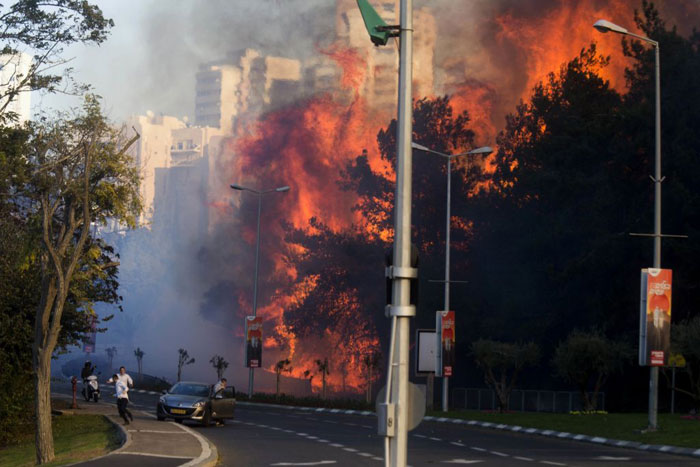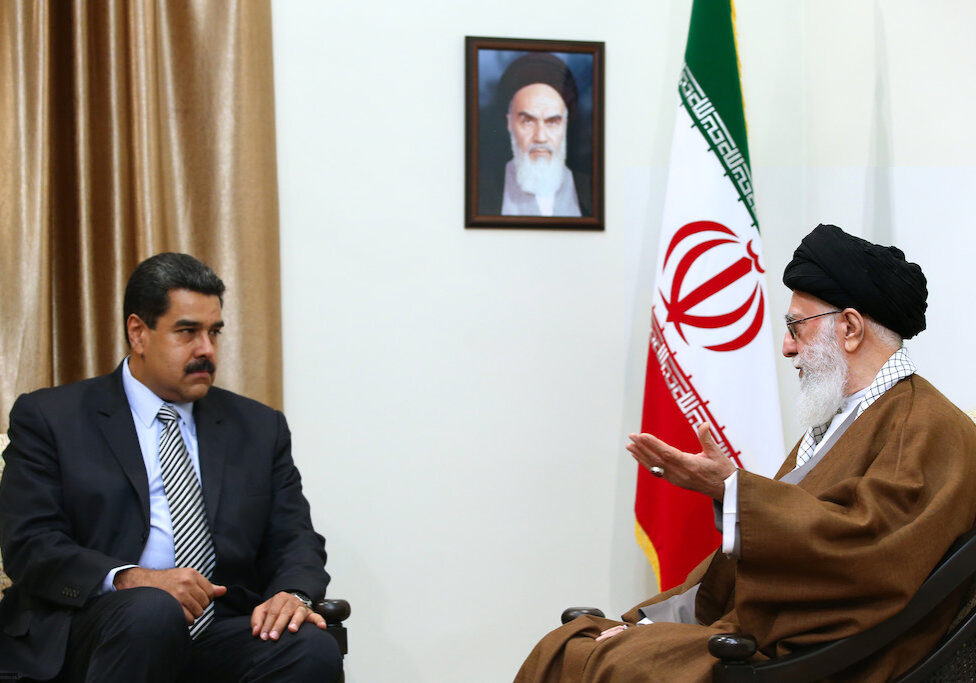Australia/Israel Review
Behind the News – January 2017
Jan 9, 2017 |

TERROR AND ROCKET REPORT
Terrorism took a new twist in Israel last month with a number of the many bushfires that devastated areas of the country, including Haifa, allegedly having been started deliberately as terrorist acts – while Hamas and other Palestinian and Arab groups and individuals celebrated the effects online. At least 12 people were arrested by Israeli police on charges of starting fires during the emergency.
A small number of attempted stabbings and shootings, together with numerous incidents of Palestinians throwing rocks and Molotov cocktails at Israeli forces and civilians, as well as at firefighters, occurred during the past month. Meanwhile, on Dec. 5, Israeli forces conducted a raid that led to large numbers of weapons being seized in Hebron.
On Nov. 26, Egypt flooded three smuggling tunnels on the Gaza-Egypt border, allegedly killing four Palestinians. There were no rocket attacks from Gaza in November or the first two weeks of December.
ISRAELI STRIKES IN SYRIA
On Nov. 27, Israeli forces engaged ISIS-affiliated fighters on the Syrian border in the first direct military confrontation between the two groups. Soldiers from the Golani Brigade were attacked by ISIS fighters across the border, while the IDF responded with an airstrike on the ISIS position, killing four terrorists. Speaking after the attack, Prime Minister Netanyahu said, Israel “won’t allow Islamic State figures or other enemy actors, under the cover of the war in Syria, to set up next to our borders.”
Arab media alleged two additional attacks in Syria by Israeli forces – a Dec. 7 airstrike on the al-Mezzeh Airport, west of Damascus, which is believed to be the headquarters of Syrian Air Force Intelligence, and an earlier airstrike which destroyed a weapons warehouse and a convoy travelling on the Damascus-Beirut highway the previous week. According to a Hezbollah defector quoted in the Kuwaiti newspaper Al Rai, these attacks foiled an attempt to send a portion of Syrian President Bashar Assad’s chemical weapons stockpile to Hezbollah. Israeli Defence Minister Avigdor Lieberman appeared to come close to confirming these reports when he told a Knesset committee on Dec. 8 that Israel was taking action to prevent Hezbollah getting “advanced weapons, military equipment and weapons of mass destruction.”
IDF EXPOSES HEZBOLLAH POSITIONS
On Dec. 6, the Israel Defence Force released a map of southern Lebanon identifying 10,000 Hezbollah military sites located in 200 towns along the border.
All surrounded by civilians and in violation of the UN Security Council resolutions which ended the last Lebanon war in 2006, the positions include weapons warehouses, rocket launchers, infantry, underground tunnels and infrastructure, anti-tank positions and command posts.
Via the UN Security Council, Israel has also accused Iran of using commercial flights to transfer weapons to Hezbollah. “It is clear that Iran is still the primary supplier of arms and related materiel to Hezbollah, in blatant violation of numerous Security Council resolutions,” Israel’s UN Ambassador Danny Danon said.
Those accusations came as aerospace giant Boeing signed a deal to provide the Islamic Republic with 80 new civilian aircraft worth almost US $17 billion in December.
And it appears Iran isn’t Hezbollah’s only friend. Pro-Hezbollah news site al-Akhbar reported in late November that officials from the group met officially with senior Russian officials in war-torn Aleppo, to establish “continual communication and shared channels” between Moscow and the terror group. Israeli experts say that even before this meeting there were clear signs that Russia was coordinating directly with Hezbollah in Syria.
SIGNS OF HAMAS-IRAN RAPPROCHEMENT
Ties between Iran and Hamas appear to be strengthening, with senior Hamas official Osama Hamdam proclaiming in mid-November that “relations between Iran and Hamas are currently undergoing revitalisation, and moving in the right direction,” and further stating that Iran would “continue to support the resistance.” Khaled Abu Toameh writes that a further sign of the improved relations was the recent appointment of Emad El-Alami as temporary leader of Hamas in the Gaza Strip, replacing long-time leader Ismail Haniyeh, now abroad. El-Alami has close relations with the Iranian regime, having previously been Hamas’ emissary to Teheran.
Relations between Iran and Hamas hit a low point when Hamas refused to back Syrian President Bashar al-Assad and his regime, one of Iran’s key allies. The two groups, however, continue to share the stated ambition of destroying Israel, with Iran having historically backed the group both politically and financially, and having also funnelled weapons to Hamas.
KENYA ARRESTS IRANIAN TERROR SUSPECTS
Kenyan prosecutors have charged two Iranian nationals, Sayed Nasrollah Ebrahim and Abdolhosein Gholi Safee with terror offences after they were arrested taking photos of the Israeli Embassy on Nov. 29 in an Iranian diplomatic car. Kenyan authorities recovered the photos and believe the men were canvassing the Embassy for a future attack.
This is not the first time Iranian nationals have been charged and imprisoned in Kenya on terror-related charges. Two Iranian men were sentenced to life in prison (later reduced to 15 years imprisonment) in 2013 for plotting attacks against Western targets. In 2002, terrorists bombed a hotel in Mombasa popular with Israeli tourists, killing 13 people including three Israelis.
IRAN ARRESTS 12 NEGOTIATORS
Israel’s Channel 2 reported on Nov. 18 that Iran had arrested, on charges of espionage, at least 12 senior officials who were members of its team that negotiated with the West on the nuclear deal. Earlier this year, Iranian authorities arrested another member of the negotiating team on suspicions of spying, while in August it executed Shahram Amiri, a nuclear scientist who was arrested for spying in 2010 after he had returned from the US.
ISIS CHEMICAL WEAPONS AND SUICIDE ATTACKS
According to London-based intelligence collection and analysis service IHS Conflict Monitor, ISIS has used chemical weapons at least 52 times on battlefields since its 2014 capture of vast areas of Syria and Iraq. These conclusions are based on local media reports, reports on social media and ISIS propaganda. Col. John Dorrian, a US military spokesman in Iraq, described the attacks as rudimentary, saying they are generally rockets or shells filled with chemical agents such as sulphur mustard or chlorine.
Meanwhile, ISIS has claimed to have carried out 1,034 suicide attacks in the first eleven months of 2016, in Iraq, Syria and also Libya. The Foundation for Defence of Democracies arrived at this figure by tallying infographics released each month by ISIS’s Amaq News Agency. The overwhelming majority of these have been in areas of Iraq ISIS is struggling to retain, such as Mosul.
WHEELCHAIRS OF HOPE
An Israeli businessman, using money from both private sources and from Israel’s Office of the Chief Scientist, has developed a special wheelchair for children in the Third World that can handle rough off-road conditions and costs under US$100 to produce.
The first units from the Wheelchairs of Hope project, which was set up by businessman Pablo Kaplan together with Israeli medical rehabilitation specialists, were to be delivered to Israeli and Palestinian children in December, with a batch for children in Syrian refugee camps also scheduled for delivery. Another 600 wheelchairs are being delivered to disabled children in Peru and Tajikistan.
A ceremony to launch the project was held at Jerusalem’s Alyn rehabilitation hospital on Dec. 7, with representatives from the World Health Organisation, UNICEF, USAID, and rehabilitation organisations from both Israel and the Palestinian Authority in attendance.
Tags: Iran






